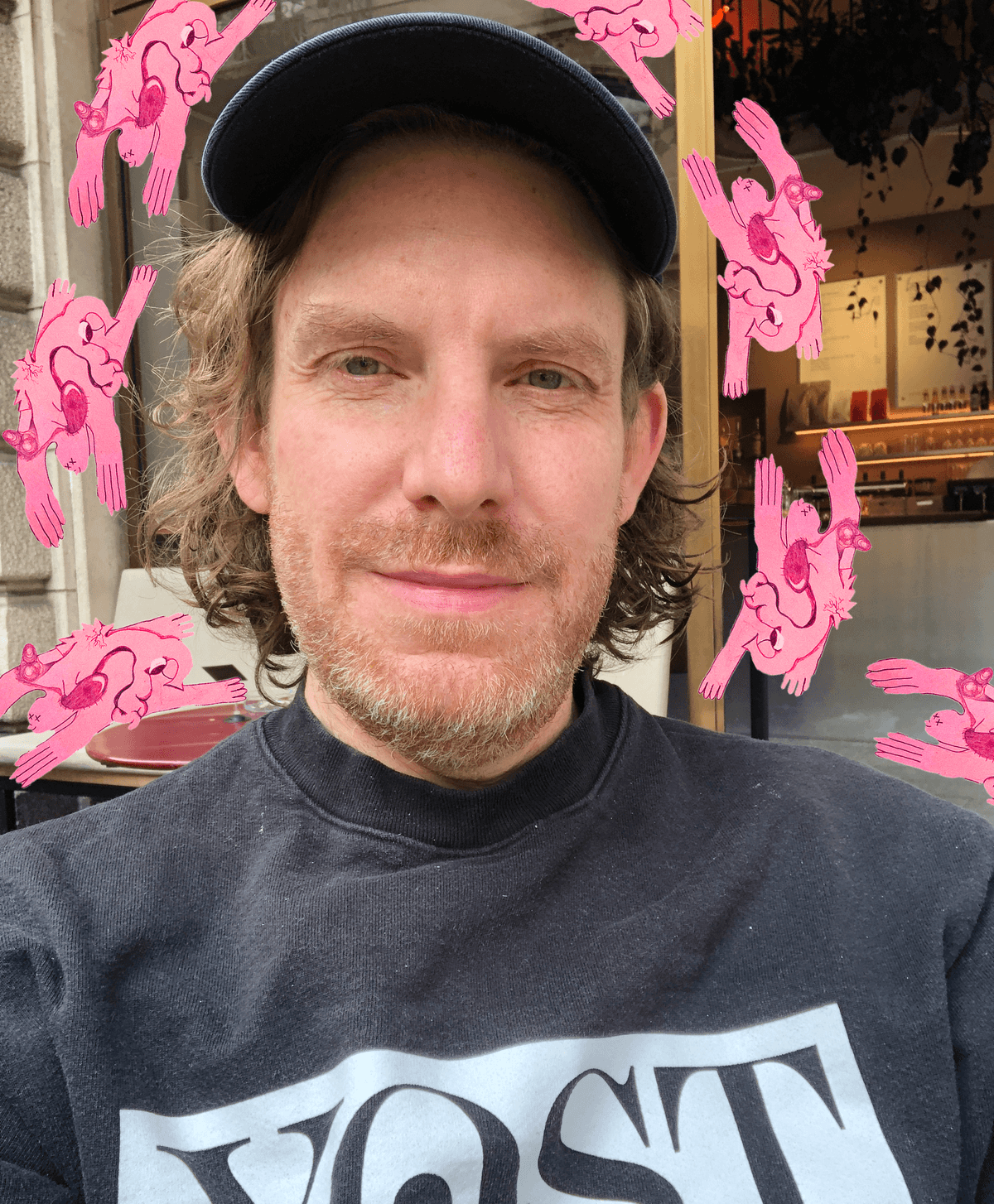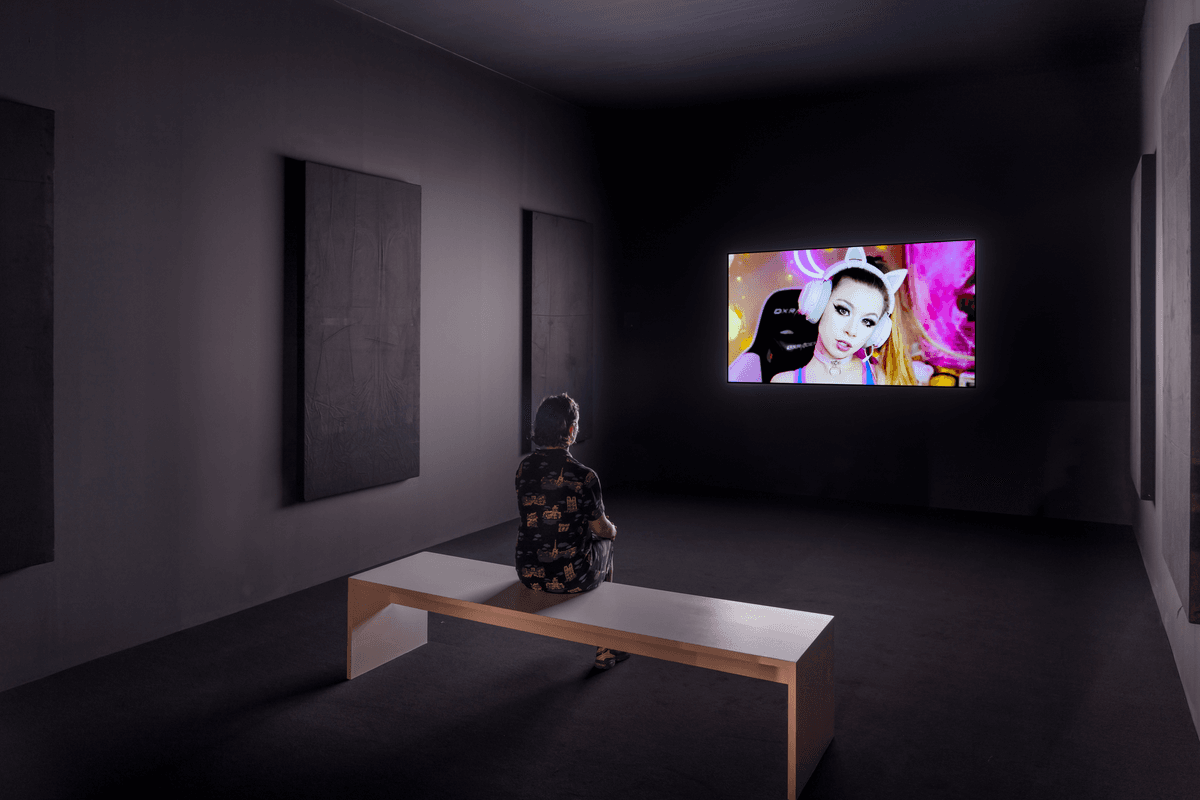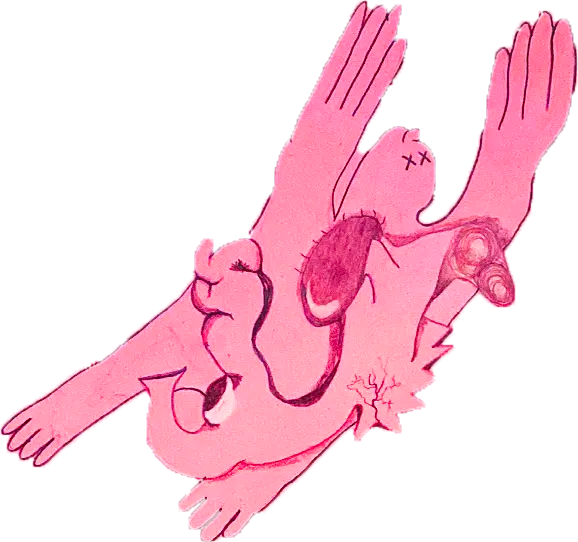DIGITAL DISCOURSE
Cory Arcangel

“I’m on the cusp of what could be considered the second wave of internet artists. My first love was MTV.”
TESS POLLOK: It’s hard to quantify your work–you’re a post-conceptual artist often identified as an internet artist because you work primarily with new media, especially video games and computers. I’ll revisit that in a minute, but I wanted to start by asking about your new projects: you’re curating an upcoming show, ALL I EAT IN A DAY, at Kunsthalle Sankt Gallen in St. Gallen, Switzerland; for our American audience, it might be more accessible to discuss ART on THE MART’s 2024 program, which debuts its summer season in Chicago on June 6, 2024, and includes a new commission from you.
CORY ARCANGEL: The Sankt Gallen show is opening in September of this year and I’m really pumped about it. They have a really interesting aesthetic; they’re almost aggressively avant-garde. [Laughs] I’m co-curating the show with director Giovanni Carmine and we wanted to put things in it that are just on the edge of art, so we conceptualized the curation around mediums that are more touchy in the traditional contemporary world–things like NFTs, sneaker collaborations, immersive VR installations. The show offers a kind of poetics around these things. Beyond that, I have a show opening next week in Chicago, as you mentioned.

Cory Arcangel installation at Art Basel 2023
I’ve been feeling a little lost lately with social media. I don’t like Instagram so information about my work and upcoming shows can all be tracked on my personal site. It’s become a practical problem for me as an artist because I need a way to let people know what I’m doing but I’ve completely lost my footing in the social media world and don’t feel an urge to re-enter it at that level.
POLLOK: My day job is in social media so I’m completely immersed in that world. The reality you’re describing is utterly jarring to me but I respect it. I’m scrolling through your site now and I noticed you have a new YouTube project, “Let’s Play Majerus G3 📽” Are you a streamer now? You should make a Twitch.
ARCANGEL: [Laughs] Yah, it’s my debut as a streamer. I’m actually technically just a YouTuber because I didn’t stream it– the video was edited prior to publishing. Let's Play Majerus G3 is a series of YouTube videos based around the restoration of the laptop and digital studio of the artist Michel Majerus.
POLLOK: Who’s that?
ARCANGEL: The most basic way to describe him is that he was a painter and installation artist, but that’s facts only. He had a very brief career–he was active in the ‘90s through 2002, when he died in a plane crash–but in the ten years that he was active he was extraordinarily prolific. His work involved paintings or installations or some combination of the two and it was always so blindingly current to the day. Contemporary art often has a lag on it, so, for example, if you make a painting in ‘94 and it actually looks like it’s from ‘94, that’s a rare feat! But it was something that Majerus consistently accomplished. Another way of saying this is that he’s one of my favorite artists of all time. 30 years later, his work still looks so great!
The next part of this story is that I became quite interested in and borderline obsessed with his work about ten years ago, so I started traveling to his estate in Berlin once a year as a kind of hobby, just to get more familiar with his work. That was when I discovered he had a Mac laptop for the last few years of his life and I suggested to his estate that it would be cool to try and get it running again. We spent seven years with a team of engineers, in collaboration with Rhizome, working to get his laptop to boot up again and this YouTube series is the result of that project. The YouTube series mostly consists of me going through his laptop in the style of a chess YouTuber and talking about the different things that I find, a lot of which have art historical significance or are significant to the technology of the time. We’re releasing five episodes of it over the next year and the first one is already out, obviously.
POLLOK: That’s so fascinating. What did you find on his computer?
ARCANGEL: The first big surprise was that when we finally got it to boot up it was almost completely full, which was amazing. In all the years we were working on the project–we started in 2017– we didn’t even know if it would work or if we would be able to retrieve anything at all. This is a computer from 2002. It’s 24 years old! But we found everything you would find in a traditional artist’s archive, including correspondence to gallerists, sketches, notes, even drafts of his paintings. He designed a lot of his paintings in Photoshop so a lot of the Photoshopped sketches of his paintings are in there. We also found a lot of incredible multimedia software, and things dating to that time period, like AOL and Napster. It’s basically a perfectly preserved early digital artist’s studio.
It’s also crazy that we were able to do this because this wouldn’t be possible now. If any of us were to leave behind our virtual lives right now, most of it would be password protected or in the Cloud or just totally gone. But this computer dates back to a brief period when people were carrying all of their files around with them. So this was a very rare and lucky find. It’s even more lucky that he happened to be an early digital artist so a lot of the material we found is born digital.
POLLOK: Did you find anything weird that you shouldn’t have found?
ARCANGEL: [Laughs] That’s a great question. Thankfully, no, because before I had access to the computer, it went through a round of scrubbing with the engineers and the estate. So they removed all personal material from it before I started the YouTube project. What I discuss in the YouTube series is all art and art historical material.
POLLOK: Okay, perfect. I just had a dark vision of you and a bunch of internet trolls ripping into this dead guy over his diary. But I’m glad that’s not what’s happening.
ARCANGEL: Well, that’s one of the reasons it took so many years. We had to figure out how to do it correctly and respectfully.
POLLOK: Get ready for a huge pivot. Now that we’ve talked about your upcoming work, I want to circle back to your storied legacy as an early internet artist. What was it like being a pioneer in that field of art? What drew you to the internet as a subject?
ARCANGEL: I was a TV art person first, or experimental television as it was called then. When I was a teenager I loved watching television, I loved MTV. And so I always had a close relationship to my television and that shifted over to the computer when one arrived at some point in my childhood. I always liked the idea, especially with TV, that it could be possible to reverse the signal. TV back then was broadcast-only so NBC and ABC and all these other channels would broadcast from New York to my hometown of Buffalo, but Buffalo also had a very active and experimental public access scene. So I knew it was possible to broadcast self made stuff into the home. It’s hard now to explain how mind blowing that reversal was, but it was!
So it was my dream to make television but by the time I got to college in ‘96 the internet happened and I realized if I made a website, I could show up in anyone’s house. So, my interest in the internet was sort of transplanted from an interest in TV, which is how it was with a lot of the first wave of internet artists I met coming up at that time. Many of them were video artists, or at least artists in other fields before coming to the net.
POLLOK: Who would you consider to be “first wave internet artists?”
ARCANGEL: Well, at least those I was looking at, would be Olia Lialina, Heath Bunting, Wolfgang Staehle, Alexei Shulgin, Yael Kanarek, and Auriea Harvey, for starters! People who I discovered around the internet mailing lists at that time, like Rhizome, or the Thing, or Nettime. But it’s well known that most internet artists of the first generation started with video art or some other multimedia form of art and then transitioned to internet art. I’m on the cusp of the second wave, I’m of an age where I could kind of start making art on the internet. Or, to be more specific, according to Olia Lialina’s great net art generations genealogy, I'm a first, last and third generation net artist. Surf clubs, which came a bit later, were also important, there were what seemed like hundreds of them at one point.
POLLOK: What are or were surf clubs?
ARCANGEL: I’m not sure what the technical definition would be, but they were groups of blogs, sometimes on Tumblr or Blogspot or Wordpress, where large groups of artists would all post things. I think people would best understand it as a Tumblr. Each had its own flavor and it became a centralized way for discovering art and expressing yourself.
POLLOK: Oh, like The Jogging.
ARCANGEL: Exactly!
POLLOK: And what about Related to Your Interests–that’s a YouTube channel you put together using an algorithm?
ARCANGEL: Yeah, the videos were generated by a bot that ran for 2 years, in 2020 and 2021. I wrote it with Henry Van Dusen–actually, Henry wrote it, mostly. So basically it is a clickbait scraper–every day the bot goes to trashed out websites with tons of ads and scrapes all the text and smashes it together in these gibberish ways. Then we used a machine learning API to read the text and try to figure out what the text was saying. Then we took those keywords and image searched for them. And, lastly, we combined the two to create these automatic videos where the images and text would be smashed together. There’s something like 800 of them available now. But unlike regular YouTube goals where the idea is to get people to click, this is just pure YouTube spam for the sake of YouTube spam. They’re totally illegible.
POLLOK: Final question! What about your newest installation piece, which is a part of ART on THE MART Chicago?
ARCANGEL: There’s this huge building in Chicago called The MART, it’s about two blocks long and fourteen stories high, and they’ve somehow fitted the entire surface with this billion dollar projection system that projects exactly on one side of the building. So, debuting on June 6, I’m going to have a massive video piece there running for about a month or two called 🌊💨&🔥.
POLLOK: Any last projects you want to shout out?
ARCANGEL: I’ve been working with Henry Van Dusen again more recently, and we created this thing called Cookery, which is a new software microservice for deep frying images and videos. And it was actually used to develop the video I just mentioned in Chicago. Try it out, it’s free!
Cory Arcangel is a multimedia internet artist based in Stavanger, Norway.
Tess Pollok is the editor-in-chief of Animal Blood.
← back to features
